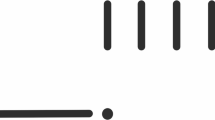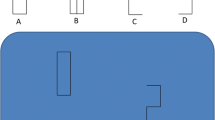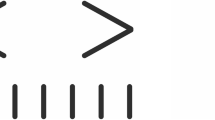Abstract
In the present study, we have tested the applicability of the computational model of centroid extraction to account for the data collected in experiments with stimuli comprising of closed two-dimensional shapes. The outlined or uniformly filled pie-shaped circular sectors (contextual distractors) were arranged according to the Brentano pattern, and three different stimulus parameters (either the radius or the central angle or the tilt angle of the sectors) were used as independent variables in different series of experiments. It was demonstrated that the model calculations adequately predict the variations of illusion magnitude shown by all the subjects for all independent variables and that there is no significant difference between the data obtained for stimuli with the outlined and uniformly filled distractors. A good correspondence between the computational and experimental data provides convincing evidence in support of the “centroid” explanation of illusions of extent of the Müller–Lyer type.






Similar content being viewed by others
References
Akutsu H, McGraw PV, Levi DM (1999) Alignment of separated patches: multiple location tags. Vis Res 39:789–801
Anstis S, Gregory R, Heard P (2009) The triangle-bisection illusion. Perception 38(3):321–32
Badcock DR, Hess RF, Dobbins K (1996) Localization of element clusters: multiple cues. Vis Res 36:1467–1472
Barrow HG, Tenenbaum JM (1981) Interpreting line drawings as three-dimensional surfaces. Artif Intell 17:75–116
Baud-Bovy G, Soechting J (2001) Visual localization of the center of mass of compact, asymmetric, two-dimensional shapes. J Exp Psychol Hum Percept Perform 27(3):692–706
Brigell M, Uhlarik J, Goldhorn P (1977) Contextual influences on judgements of linear extent. J Exp Psychol Hum Percep Perform 3(1):105–118
Bulatov A, Bertulis A, Bielevičius A, Bulatova N (2009a) Interpretation of illusions of extent based on the centroid conception. Sensornye Sist 23(1):3–12 (in Russian)
Bulatov A, Bertulis A, Bielevicius A, Loginovich Y (2009b) Distracter influence on the right angle perception. Zh Vyss Nerv Deiat Pavlova 59:259–268 (in Russian)
Bulatov A, Bertulis A, Bulatova N, Loginovich Y (2009c) Centroid extraction and illusions of extent with different contextual flanks. Acta Neurobiol Exp (Wars) 69:504–525
Bulatov A, Bertulis A, Gutauskas A, Bulatova N (2010a) Stimulus size and the magnitude of the visual illusion of extent. Hum Physiol 36(2):164–171
Bulatov A, Bertulis A, Gutauskas A, Mickiene L, Kadziene G (2010b) Center-of-mass alterations and visual illusions of extent. Biol Cybern 102:475–487
Bulatov A, Bertulis A, Mickienė L, Surkys T, Bielevičius A (2011) Contextual flanks’ tilting and magnitude of illusion of extent. Vis Res 51(1):58–64
Bulatov A, Bulatova N, Mickienė L, Bielevičius A (2013) Perceptual mislocalization of a single set of the Müller-Lyer wings. Acta Neurobiol Exp (Wars) 73:417–429
Bulatov A, Bulatova N, Surkys T (2012) Perpendicularity misjudgments caused by contextual stimulus elements. Vis Res 71:1–9
Coren S, Girgus JS, Erlichman H, Hakstian AR (1976) An empirical taxonomy of visual illusions. Percept Psychophys 20(2):129–137
Day RH (2006) Two principles of perception revealed by geometrical illusions. Aust J Psychol 58(3):123–129
DeLucia PR, Longmire SP, Kennish J (1994) Diamond-winged variants of the Muller-Lyer figure: a test of Virsu’s (1971) centroid theory. Percept Psychophys 55:287–295
Di Maio V, Lansky P (1998) The Muller-Lyer illusion in interpolated figures. Percept Mot Skills 87:499–504
Gillam B (1998) Illusions at century’s end. In: Hochberg J (ed) Perception and Cognition at Century’s End. Academic Press, San Diego, pp 95–136
Gregory RL (1968) Perceptual illusions and brain models. Proc R Sci Lond Ser B Biol Sci 171:279–296
Greist-Bousquet S, Schiffman HR (1981) The role of structural components in the Mueller-Lyer illusion. Percept Psychophys 30(5):505–511
Hirsch J, Mjolsness E (1992) A center-of-mass computation describes the precision of random dot displacement discrimination. Vis Res 32:335–346
Intriligator J, Cavanagh P (2001) The spatial resolution of visual attention. Cogn Psychol 43:171–216
Levi DM (2008) Crowding—an essential bottleneck for object recognition: a mini-review. Vis Res 48(5):635–654
McGraw PV, Whitaker D, Badcock DR, Skillen J (2003) Neither here nor there: localizing conflicting visual attributes. J Vis 3:265–273
Morgan MJ, Glennerster A (1991) Efficiency of locating centers of dot-clusters by human observers. Vis Res 31:2075–2083
Morgan MJ, Hole GJ, Glennerster A (1990) Biases and sensitivities in geometrical illusions. Vis Res 30:1793–1810
Morgan MJ, Melmoth D, Solomon JA (2013) Linking hypotheses underlying Class A and Class B methods. Vis Neurosci 30: 197–206
Morgan MJ, Ward RM, Cleary RF (1994) Motion displacement thresholds for compound stimuli predicted by the displacement of centroids. Vis Res 34:747–749
Nakayama K, Mackaben M (1989) Sustained and transient components of focal visual attention. Vis Res 29:1631–1647
Nanay B (2009) Shape constancy, not size constancy: a (partial) explanation for the Müller-Lyer illusion. In: Taatgen NA, van Rijn H (eds) Proceedings of the 31st Annual Conference of the Cognitive Science Society. Lawrence Erlbaum, Mahwah, NJ, pp 579–584
Predebon J (2001) Spatial range of illusory effects in Müller-Lyer figures. Psychol Res 65(4):226–234
Pressey AW, Pressey CA (1992) Attentive fields are related to focal and contextual features: a study of Müller-Lyer distortions. Percept Psychophys 51:423–436
Proffitt DR, Cutting JE (1980) Perceiving the centroid of curvilinearly bounded rolling shapes. Percept Psychophys 28:484–487
Proffitt DR, Thomas MA, O’Brien RG (1983) The roles of contour and luminance distribution in determining perceived centers within shapes. Percept Psychophys 33(1):63–71
Redding GM, Kramen AJ, Hankins JL (1997) The Müller-Lyer illusion as a consequence of picture perception. In: Schmuckler MA, Kennedy JM (eds) Studies in Perception and Action IV. Lawrence Erlbaum Associates, Mahwah, pp 11–14
Redding GM, Vinson DW (2010) Virtual and drawing structures for the Müller-Lyer illusions. Atten Percept Psychophys 72(5):1350–1366
Sagi D, Julesz B (1986) Enhanced detection in the aperture of focal attention during simple shape discrimination tasks. Nature 321:693–695
Vos PG, Bocheva N, Yakimoff N, Helsper E (1993) Perceived locations in two-dimensional patterns. Vis Res 15:2157–2169
Wallis TSA, Bex PJ (2012) Image correlates of crowding in natural scenes. J Vis 12(7):1–19
Watt RJ, Morgan MJ (1984) Spatial filters and the localization of luminance changes in human vision. Vis Res 24:1387–1397
Watt RJ, Morgan MJ (1985) A theory of the primitive spatial code in human vision. Vis Res 25:1661–1674
Whitaker D, McGraw PV, Pacey I, Barrett BT (1996) Centroid analysis predicts visual localization of first- and second-order stimuli. Vis Res 36:2957–2970
Whitney D, Levi DM (2011) Visual crowding: a fundamental limit on conscious perception and object recognition. Trends Cogn Sci 15(4):160–168
Wright JM, Morris AP, Krekelberg B (2011) Weighted integration of visual position information. J Vis 11(14):1–16
Acknowledgments
We are grateful to Brian Marmion for his kind assistance throughout the preparation of this manuscript.
Author information
Authors and Affiliations
Corresponding author
Rights and permissions
About this article
Cite this article
Bulatov, A., Bulatova, N., Loginovich, Y. et al. Illusion of extent evoked by closed two-dimensional shapes. Biol Cybern 109, 163–178 (2015). https://doi.org/10.1007/s00422-014-0633-3
Received:
Accepted:
Published:
Issue Date:
DOI: https://doi.org/10.1007/s00422-014-0633-3




